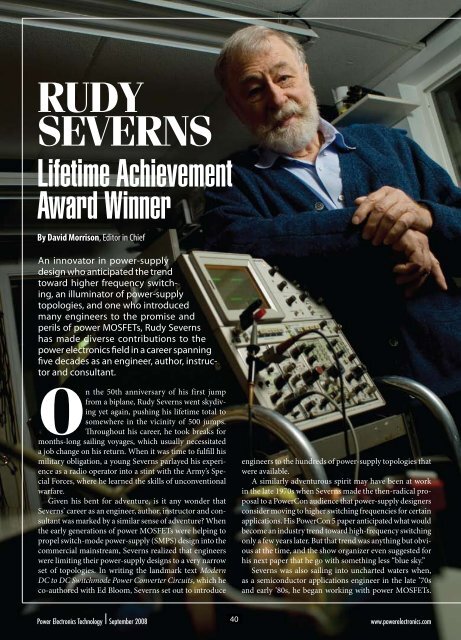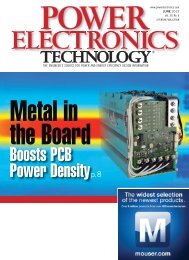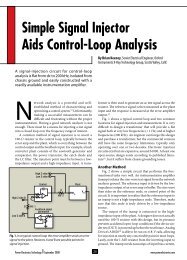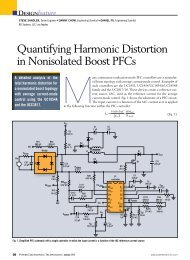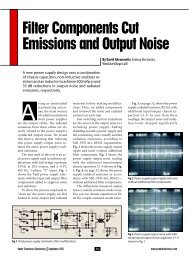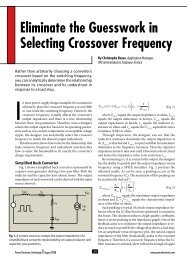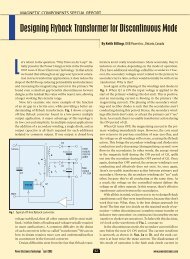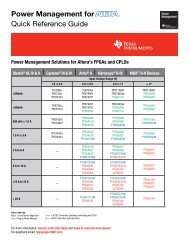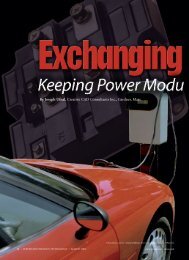Rudy SeveRnS - Power Electronics
Rudy SeveRnS - Power Electronics
Rudy SeveRnS - Power Electronics
You also want an ePaper? Increase the reach of your titles
YUMPU automatically turns print PDFs into web optimized ePapers that Google loves.
<strong>Rudy</strong><br />
<strong>SeveRnS</strong><br />
Lifetime Achievement<br />
Award Winner<br />
By David Morrison, Editor in Chief<br />
An innovator in power-supply<br />
design who anticipated the trend<br />
toward higher frequency switching,<br />
an illuminator of power-supply<br />
topologies, and one who introduced<br />
many engineers to the promise and<br />
perils of power MOSFETs, <strong>Rudy</strong> Severns<br />
has made diverse contributions to the<br />
power electronics field in a career spanning<br />
five decades as an engineer, author, instructor<br />
and consultant.<br />
On the 50th anniversary of his first jump<br />
from a biplane, <strong>Rudy</strong> Severns went skydiving<br />
yet again, pushing his lifetime total to<br />
somewhere in the vicinity of 500 jumps.<br />
Throughout his career, he took breaks for<br />
months-long sailing voyages, which usually necessitated<br />
a job change on his return. When it was time to fulfill his<br />
military obligation, a young Severns parlayed his experience<br />
as a radio operator into a stint with the Army’s Special<br />
Forces, where he learned the skills of unconventional<br />
warfare.<br />
Given his bent for adventure, is it any wonder that<br />
Severns’ career as an engineer, author, instructor and consultant<br />
was marked by a similar sense of adventure? When<br />
the early generations of power MOSFETs were helping to<br />
propel switch-mode power-supply (SMPS) design into the<br />
commercial mainstream, Severns realized that engineers<br />
were limiting their power-supply designs to a very narrow<br />
set of topologies. In writing the landmark text Modern<br />
DC to DC Switchmode <strong>Power</strong> Converter Circuits, which he<br />
co-authored with Ed Bloom, Severns set out to introduce<br />
engineers to the hundreds of power-supply topologies that<br />
were available.<br />
A similarly adventurous spirit may have been at work<br />
in the late 1970s when Severns made the then-radical proposal<br />
to a <strong>Power</strong>Con audience that power-supply designers<br />
consider moving to higher switching frequencies for certain<br />
applications. His <strong>Power</strong>Con 5 paper anticipated what would<br />
become an industry trend toward high-frequency switching<br />
only a few years later. But that trend was anything but obvious<br />
at the time, and the show organizer even suggested for<br />
his next paper that he go with something less “blue sky.”<br />
Severns was also sailing into uncharted waters when,<br />
as a semiconductor applications engineer in the late ’70s<br />
and early ’80s, he began working with power MOSFETs.<br />
<strong>Power</strong> <strong>Electronics</strong> Technology September 2008 40<br />
www.powerelectronics.com
Severns not only needed to figure out how to use these new<br />
components, he had to teach power-supply designers how<br />
to use them. That gave Severns his first foray into teaching<br />
power electronics, an activity with which he would become<br />
more involved in time.<br />
Working with those early power MOSFETs, Severns was<br />
also among those who were discovering their peculiarities<br />
and their failure modes. He wrote several papers documenting<br />
these problems, worked with customers to address these<br />
issues in their designs and then worked with his company’s<br />
device designers to eliminate some of the early MOSFET<br />
weaknesses.<br />
Prior to becoming an applications engineer, Severns<br />
worked in industry for many years designing high-voltage,<br />
high-power supplies for space, military and science applications.<br />
In these assignments, the unforgiving nature<br />
of high-voltage design undoubtedly added an element of<br />
danger and adventure to his work, while also giving Severns<br />
a grounding in SMPS technology and opportunities to<br />
innovate.<br />
But before that career started, there would be several<br />
adventures that would help shape his later life in ways big<br />
and small. As a youngster, Severns would get a taste for<br />
electronics and experimentation, beginning his lifelong<br />
involvement with amateur radio. He would receive a surprisingly<br />
good grounding in math and science at his small<br />
country high school.<br />
Then after graduation, he would get a chance to mature<br />
in the military while undergoing some rather exotic training<br />
in an Army Special Forces unit. And finally, he would enroll<br />
in a college engineering program, where he would tailor his<br />
curriculum to suit his interests, while gaining valuable work<br />
experience as a technician in particle accelerator labs.<br />
Abundant Opportunities<br />
Severns’ work during his college years with high voltage,<br />
high power and RF provided him with good experience for<br />
the engineering jobs he would take after graduating from<br />
UCLA in 1966. Severns recalls that the job situation at the<br />
time for graduating engineers was “wonderful,” as a result<br />
of the booming aerospace and military industries and the<br />
heavy funding of big science.<br />
Upon graduation, he picked up where he left off in his<br />
engineering work by taking a position at the Los Alamos<br />
Scientific laboratory, where once again he designed highpower<br />
RF amplifiers, pulse modulators and high-voltage,<br />
high-power power supplies for the lab’s linear particle<br />
accelerator. That job also gave Severns the opportunity to<br />
publish what would be the first of many papers on power<br />
and RF topics.<br />
In that first paper, Severns described techniques for<br />
transmitting a pulse across a high-voltage interface to RF<br />
pulse modulators that were floating at 50 kV to 100 kV. One<br />
of the innovative techniques used light signals transmitted<br />
over light pipes using some of the early Hewlett-Packard<br />
optoelectronic components.<br />
Severns continued designing pulse modulators and<br />
power supplies when he moved to Continental <strong>Electronics</strong><br />
Corp. in 1968. Another two years later he moved on again to<br />
take a job as design engineer at Analog Technology Corp.,<br />
where he designed power converters for spacecraft physics<br />
experiments. Then in 1971, he took a job at Hughes Aircraft<br />
Corp. This was followed by stints at Magnavox Research<br />
Laboratory from 1974 to 1978 and a short stint in 1978 at<br />
TRW, space systems division.<br />
Then as now, job hopping was fairly common among engineers.<br />
“In the early ’70s, in Southern California, jumping<br />
from one company to the next was de rigeur,” says Severns,<br />
and he did so for various reasons. “But in general, my motivation<br />
was to find something interesting to do. I looked at<br />
the work that was available and what I was doing today. If<br />
I was finishing up a project, and it was getting boring and<br />
routine, I’d go off and find a new job.”<br />
Fortunately for Severns, there were many interesting<br />
jobs in the late ’60s and early ’70s. At Analog Technology,<br />
he worked on deep-space instrumentation for projects<br />
such as the Mariner mission to Mars. Then at Hughes, he<br />
did design work (using traveling wave tube amplifiers) on<br />
some of the early communications satellites. Both jobs<br />
were “really fascinating work” that involved developing<br />
new circuits.<br />
At Magnavox, he was among those doing the early<br />
development work on global positioning systems (GPS).<br />
For Severns, the GPS project was his first opportunity to<br />
design low-voltage dc power supplies, which would power<br />
the GPS receivers.<br />
www.powerelectronics.com 41<br />
<strong>Power</strong> <strong>Electronics</strong> Technology September 2008
LiFETiME AchiEvEMEnT AwARd<br />
Chances to Innovate<br />
Nearly all of these power supplies for the spacecraft and<br />
GPS systems were SMPSs designed solely with discrete<br />
devices including bipolar junction transistors (BJTs or<br />
bipolars) for the switches. And all of the magnetic components<br />
were designed from scratch. These projects required<br />
innovation, which would require Severns to develop new<br />
circuit topologies and design techniques.<br />
For example, at ATC, Severns introduced a resonant<br />
power-supply design for space at a time when most space<br />
applications were using flyback converters. In this<br />
case, the resonant approach was motivated by the<br />
challenge of delivering high voltage at low power<br />
(milliwatts), but with very high efficiency. This<br />
work became the subject of his second paper.<br />
In this application, Severns says, “You had to<br />
supply 20 mW at 400 V from a 28-V spacecraft<br />
bus and you had to do it as efficiently as possible.<br />
That’s extremely difficult to do with hard switching.<br />
So I went with the resonant approach, which<br />
required some innovation.”<br />
At Hughes, his work with traveling wave<br />
tube amplifiers required him to invent circuits<br />
that could achieve high efficiency and very light<br />
weight. “That’s really where I started to invent<br />
new circuits and new topologies,” says Severns.<br />
The demand for very light weight together<br />
with small size would also be a motivating requirement<br />
at Magnavox. “That’s where I started doing very-highfrequency<br />
work,” says Severns.<br />
In the late ’70s, the standard for switchers was 20 kHz<br />
to 25 kHz. At Magnavox, Severns pushed the switching<br />
frequency beyond 100 kHz, even developing a tiny (for the<br />
time) SMPS running at 600 kHz. That work was the basis for<br />
two groundbreaking papers that he presented at <strong>Power</strong>Con<br />
and the <strong>Power</strong> <strong>Electronics</strong> Specialists Conference (PESC)<br />
in 1978 and eventually led to Severns’ appointment as an<br />
IEEE fellow.<br />
The <strong>Power</strong>Con paper, “Design of High-Efficiency Offline<br />
Converters Above 100 kHz” was one of the earliest to<br />
discuss the possibility of higher-frequency operation.<br />
“It was the first real proposal in a large power-supply<br />
forum that said, ‘Think about much higher switching<br />
frequencies.’” The paper was very popular, even receiving<br />
a best paper award, but it was also controversial. Severns<br />
recalls that Ron Birdsall, the organizer of the event, suggested<br />
that Severns write about something less “blue sky”<br />
and more practical for his next conference paper. But within<br />
two or three years, high-frequency switching wasn’t blue<br />
sky anymore.<br />
In addressing the <strong>Power</strong>Con audience, Severns took<br />
care to explain that high-frequency switching was an option,<br />
rather than a necessity in all cases. But this message<br />
was not heard.<br />
Severns recalls, “When I presented the paper, I was extremely<br />
careful to say, I am not telling you that you should<br />
operate at these frequencies. I am telling you that in certain<br />
situations you can and you may wish to operate at these<br />
frequencies. Of course, within months everyone was saying<br />
that I was advocating that we all shift to this frequency.”<br />
Severns notes that in later years, he went so far as to tell<br />
designers to decrease switching frequencies when higherfrequency<br />
switching wasn’t warranted.<br />
At the time Severns presented his paper, the use of SMPS<br />
technology was well established within the military and<br />
aerospace industries. However, it had not yet been accepted<br />
“<strong>Power</strong> electronics<br />
is alive and well.<br />
Everywhere I look,<br />
I see opportunities.”<br />
within the commercial industry. It’s frequently said that<br />
the arrival of the power MOSFET enabled the adoption<br />
of switch-mode technology by commercial power-supply<br />
merchants in the late ’70s and early ’80s.<br />
According to Severns, the power MOSFET also enabled<br />
the migration to the higher switching frequencies he was<br />
describing in his papers. “Almost immediately after I gave<br />
my paper, the power MOSFET came on the scene and<br />
designers didn’t have to go through the effort I did to make<br />
BJTs work at 150 or 200 kHz.”<br />
Nevertheless, the transition to higher frequencies did<br />
not happen overnight. It would take 10 years before the<br />
MOSFETs would become cheap enough that designers<br />
would use them en masse and be able to routinely design<br />
power supplies to operate at higher frequencies, according<br />
to Severns.<br />
Adventures in Semiconductors<br />
When Severns gave his <strong>Power</strong>Con paper in San Francisco,<br />
the sales manager from Intersil was in the audience.<br />
“With some later arm twisting, he dragged me up to go<br />
to work for Intersil, because they were simultaneously<br />
[along with Siliconix, Hewlett-Packard and International<br />
Rectifier] coming out with power MOSFETs.<br />
“Intersil lured me away, but I was easy to lure because it<br />
was really different. Developing hardware is one world. The<br />
semiconductor industry is another world,” says Severns.<br />
At the time he started working at Intersil as a field<br />
applications engineer (FAE), the only design he had com-<br />
<strong>Power</strong> <strong>Electronics</strong> Technology September 2008 42<br />
www.powerelectronics.com
pleted using a power MOSFET was the 600-kHz switcher<br />
described in his PESC paper. “Now I understood the principles,<br />
but from principles to writing application notes and<br />
giving lectures, it’s a long jump.”<br />
However, Severns learned quickly about how MOSFETs<br />
work, and how their particular characteristics and flaws<br />
could lead to failures in the applications. He then had to<br />
instruct customers in how to use the new transistors and<br />
how to avoid pitfalls.<br />
“For instance, somebody would put two MOSFETs in<br />
parallel and they would start oscillating. That’s because<br />
these things have gain up in the ultrahigh-frequency region.<br />
So my job was to figure out how to prevent that. And there<br />
were other strange operating modes having to do with dv/<br />
dt,” says Severns.<br />
“The early MOSFETs, for example, they would switch<br />
very fast. But when you started doing that with more than<br />
one of them in the circuit, a device would be in the off state<br />
and have this tremendous dv/dt applied across it. So, the<br />
one that was supposed to be off would be turned on due to<br />
intrinsic parasitics,” explains Severns.<br />
Severns notes that his counterparts at the other power<br />
MOSFET companies were also addressing these problems,<br />
though he was among the first to write about dv/dt and<br />
other issues such as parasitic oscillation in parallel devices,<br />
radiation effects and avalanche-induced turn off. Most<br />
of these issues were addressed through semiconductor<br />
processing.<br />
“My job was to identify the problem, explain to the world<br />
what the problem was and how to avoid it until we fix it<br />
right,” says Severns. “And at the same time, I had to tell the<br />
device designers in the process department, ‘Change your<br />
design so we don’t have to tell the world that we have this<br />
problem.’”<br />
In 1980, his work as an FAE also gave him his start as a<br />
teacher, which included giving presentations to engineers<br />
about MOSFETS. “The MOSFET’s a new product. We<br />
have to sell the engineering community on how to use<br />
this product. That’s when I started giving lots and lots of<br />
seminar talks.”<br />
Though he did this initially for Intersil, he would later<br />
present similar seminars for International Rectifier and<br />
Siliconix. In time he would expand into teaching powersupply<br />
design seminars for Ed Bloom, and for others such<br />
as the University of Wisconsin at Madison and Oregon<br />
State University.<br />
In Boredom, Inspiration<br />
“In 1980, while working for Intersil, I wrote the first tract<br />
on how to invent new topologies. I wrote what’s called the<br />
kama sutra of power-supply topologies. It’s a 40- or 50-page<br />
application note full of dozens and dozens of circuits. And a<br />
lot of them are new or showing likeness between old ones.<br />
The whole idea was here’s how you invent power-supply<br />
topologies.”<br />
“I had given a couple papers before touching on the sub-<br />
LiFETiME AchiEvEMEnT AwARd<br />
ject. Topology invention for me really started when I worked<br />
at Hughes and I never let that thread go. So for Intersil, I<br />
wrote this humongous application note for SMPS people<br />
saying here are all the ways you can use it. Of course, all of<br />
the models in there use MOSFETs for switches, naturally.<br />
Ed Bloom looked at that application note and said, ‘Couldn’t<br />
we write a book on that?’”<br />
After that suggestion, some time passed and Severns<br />
embarked on his sailing trip to Mexico and Hawaii. Severns<br />
notes that normally he could forget about engineering for<br />
several months at a time, but that was more difficult to do<br />
on such a long voyage.<br />
“So, I’m on my cruise, and it’s about seven or eight<br />
months into the cruise. I’m in Kāne’ohe Bay, Hawaii. I’m<br />
sitting in paradise absolutely bored to death. So I say, ‘Ed,<br />
I am going to write a book.’ And I sat down with a pencil<br />
and a pad of yellow-lined paper on the boat and wrote in<br />
longhand everyday for a few hours.”<br />
“And then I just kept mailing these packages to Ed<br />
Bloom, one chapter at a time. His wife, Joy, is transcribing<br />
on an early Apple computer. She is taking all of this<br />
chicken scratch on yellow-lined paper and writing this all<br />
up. Then Ed goes through and checks everything.” Out of<br />
this work emerged Modern DC to DC Switchmode <strong>Power</strong><br />
Converter Circuits.<br />
“The book would not have happened without Ed Bloom’s<br />
efforts. He prodded me to write it. He did a tremendous<br />
amount of work, about 80% of the work. And Ed added a<br />
chapter 12 on converters with integrated magnetics.”<br />
Severns says he was amazed at the reception the book<br />
received. “We have sold several thousand copies, and it has<br />
been translated illegally into several languages. It’s not the<br />
world’s greatest technical book at all, it’s just sort of a show<br />
and tell,” says Severns. “But the main comment I got back<br />
was how easy it was to read and create new ideas from. That<br />
was part of the reason for its success. The other part was that<br />
there was nothing like it other than the application note I<br />
had written at Intersil.”<br />
“Engineers working in the field were choosing powersupply<br />
topologies from a very, very narrow set at the time,<br />
and we just wanted to jog them a little bit. Now, given the<br />
experience over the past 25 years since the book was written,<br />
having hundreds of circuits has only had a small impact<br />
on the field,” comments Severns. “People are still using the<br />
same relatively small set of topologies for large commercial<br />
activities (i.e., high-volume, low-cost products). The book<br />
really had its impact in more specialized military, space and<br />
medical applications.”<br />
At the time he wrote the book on topologies, Severns<br />
was well into his career as an independent consultant. In<br />
that role, he continued to give seminars, write papers and<br />
participate in industry conferences.<br />
New Engineering Challenges<br />
A few years ago, Severns took down his consulting<br />
shingle and retired. But for Severns, retirement has given<br />
www.powerelectronics.com 43<br />
<strong>Power</strong> <strong>Electronics</strong> Technology September 2008
LiFETiME AchiEvEMEnT AwARd<br />
him an opportunity to pursue his interests in amateur radio<br />
more intensively. His involvement with power electronics<br />
and amateur radio, he believes, are closely linked.<br />
“Certainly for me, they’re one item, a single thread, really.<br />
All of my early work stems from being a teenager trying to<br />
build a transmitter. That’s all analog, and with transmitters<br />
you’re immediately into high voltage and high power. Today,<br />
the theme continues as I’m doing a lot of experimental<br />
electromagnetics work in antennas.”<br />
Severns has been busy publishing his results in various<br />
amateur radio magazines and also on his Web site. But<br />
ultimately, he’d like to make a contribution to the amateur<br />
radio field by writing a book in which he explains details<br />
surrounding the operation of vertical antennas, grounds<br />
and ground antennas. Within these topics there are issues<br />
that have either been “misexplained, ignored or are matters<br />
of contention,” says Severns.<br />
To support these endeavors, Severns has gone back to<br />
school. For the last four years, he has been taking courses<br />
in mathematics and electromagnetics at the University of<br />
Oregon to bring himself up to speed on the field.<br />
And despite his attempts to retire from power electronics,<br />
just this year he completed a book on snubber design<br />
at the urging of Jerrold Foutz, a longtime industry veteran.<br />
The book, Snubber Circuits for <strong>Power</strong> <strong>Electronics</strong>, explores<br />
an area of power-supply design that is absolutely critical<br />
Mission<br />
Critical<br />
Applications<br />
■ MADE IN USA<br />
■ LONG-LIFE<br />
■ HIGH RELIABILITY<br />
1205 McConville Road ■ Lynchburg, Virginia 24502<br />
tel. 434.239.6941 ■ fax. 434.239.4730<br />
www.paktron.com<br />
in high-power applications.<br />
And while he views himself as being out of the power<br />
electronics business these days, Severns may yet take some<br />
of the knowledge he has “salted away” and write additional<br />
books on power design topics. If he does, it will be another<br />
opportunity for Severns to influence future generations of<br />
engineers working in the power electronics field.<br />
With demands for energy efficiency driving technology<br />
development and applications like smart power grids<br />
emerging, Severns believes “power electronics is alive and<br />
well.”<br />
“There’s a whole field available to young engineers,” says<br />
Severns. “Everywhere I look, I see opportunities.”<br />
Editor’s Note<br />
For additional information about <strong>Rudy</strong> Severns’ life and<br />
career, please check out the online version of this article at<br />
www.powerelectronics.com.<br />
You’ll learn about Severns’ early experiences in “Small<br />
School, Quality Education,” “First Steps in <strong>Electronics</strong>”<br />
and “A Quick Start in Engineering.” Another influence on<br />
Severns’ career path was his love of sailing. To read about<br />
how his ocean-going adventures took his career in new<br />
directions, see “Setting Sail.”<br />
A complete list of works by Severns, including those<br />
referenced in this article, are also available online.<br />
MULTILAYER POLYMER (MLP) CAPACITORS<br />
■ Ultra low ESR and ESL<br />
■ High Ripple Current Handling<br />
■ Stable Under AC & DC Voltage<br />
■ Military/Telecom/Datacom 99.999% (5x9) Up Time<br />
■ Low Profile For Surface Mount<br />
■ Robust Mechanical and Electrical Design<br />
■ 50 to 500 Volts<br />
APPLICATIONS<br />
■ 48 Volt Telecom/Datacom<br />
■ HEV - Hybrid Electric Vehicle Boost Converters<br />
■ High Voltage Bus from 48 to 440+ Volts<br />
■ PFC Front Ends & SMPS Off-Line<br />
■ RFI/EMI Suppression<br />
www.paktron.com<br />
AVAILABLE THROUGH THESE DISTRIBUTORS:<br />
Atlantic Components (1-800-433-6600)<br />
Cornell Dubilier/Mallory (1-508-996-8561)<br />
Future (1-800-388-8731)<br />
Gopher (1-800-592-9519)<br />
<strong>Power</strong> <strong>Electronics</strong> Technology September 2008 44<br />
www.powerelectronics.com


